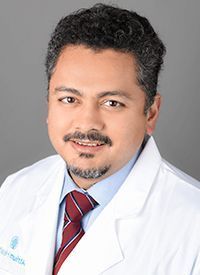Cilta-Cel Induces Deep, Durable Responses in Relapsed/Refractory Multiple Myeloma
Ciltacabtagene autoleucel continued to yield early, deep, and durable responses after longer follow-up in patients with relapsed/refractory multiple myeloma.
Saad Z. Usmani, MD, FACP

Ciltacabtagene autoleucel (cilta-cel) continued to yield early, deep, and durable responses after longer follow-up in patients with relapsed/refractory multiple myeloma (MM) with a manageable safety profile, according to updated results from the CARTITUDE-1 trial presented at the 2021 European Hematology Association (EHA) Congress.
At the meeting, Saad Z. Usmani, MD, FACP, director of the Plasma Cell Disorder Program and director of clinical research in hematologic malignancies at Atrium Health, presented updated results from the phase 1b/2 trial (NCT03548207) with a median follow-up of 18 months.
Overall response rate (ORR) was 97.9%, including a 94.8% very good partial response (VGPR) or better. Moreover, the stringent complete response (sCR) rate was 80.4% and the partial response rate (PR) was 3.1%.
The median time to first response was 1 month (range, 0.9–10.7), with a time to best response of 2.6 months (range, 0.9-15.2). The median time to complete response or better (≥CR) was 2.6 months (range, 0.9-15.2). Duration of response was 21.8 months (95% CI, 21.8–not estimable [NE]), and median duration of response had not been reached in patients with sCR. The investigators estimated that 73% of responders had not progressed or died at 12 months.
Moreover, response rates were comparable across subgroups (range, 95%–100%), including number of prior lines of therapy, refractoriness, extramedullary plasmacytomas, and cytogenetic risk.
Of the 61 evaluable patients for minimal residual disease (MRD), 91.8% achieved MRD negativity at the 10-5 threshold, including 89.4% with ≥CR, compared with 57.7% and 43.3% of all patients, respectively. Median time to MRD negativity at 10-5 was 1 month (range, 0.8-7.7).
Among all patients, the 18-month progression-free survival (PFS) rate was 66.0% (95% CI, 54.9%-75.0%), and 75.9% (95% CI, 63.6%-84.5%) in those with sCR. Median PFS among all patients was 22.8 month (95% CI, 22.8 to NE) and was not reached in those with sCR.
Lastly, the 18-month overall survival (OS) rate in all patients was 80.9% (95% CI, 71.4%-87.6%).
The investigators did not identify any new safety signals with longer follow-up.
Cytokine release syndrome (CRS) occurred in 92 patients, of which the majority (94.6%) were grade 1/2 in severity. The median time to onset of CRS was 7 days (range, 1-12); however, the events resolved in 91 patients (98.9%) within 14 days of onset.
In addition, there was no new incidence of neurotoxicity with longer follow-up, and no additional movement and neurocognitive treatment-emergent adverse events (TRAEs).
No patient discontinued therapy due to manufacturing failure, while 1 patient received retreatment with cilta-cel.
In total, 21 patients died during the study, of which 10 were due to progressive disease, 6 from TRAEs as assessed by the study investigator, and 5 were from AEs unrelated to treatment.
Usmani noted that new patient management strategies have been implemented in the trial to prevent and reduce the incidence of neurotoxicity, including enhanced bridging therapy to reduce tumor burden, early and aggressive treatment of CRS and immune effector cell–associated neurotoxicity syndrome, and handwriting assessments and extended monitoring.
“Patient management strategies to prevent or reduce these AEs have been successfully implemented in new and ongoing cilta-cel studies,” the investigators wrote. “This is reliant on effective implementation of these patient management strategies.”
The study was designed to evaluate cilta-cel, a chimeric antigen receptor (CAR) T-cell therapy with 2 B-cell maturation antigen (BCMA)–targeting single-domain antibodies, in patients with relapsed/refractory MM who have been heavily pretreated.
Patients received a single cilta-cel infusion with a target dose of 0.75 × 106 CAR-positive viable T cells/kg and a median dose of 0.71 × 106 CAR-positive viable T cells/kg (range, 0.5–1.0 × 106 CAR+ viable T cells/kg) 5 to 7 days after lymphodepletion with 300 mg/m2 cyclophosphamide and 30 mg/m2 fludarabine daily for 3 days. Bridging therapy was permitted after apheresis.
The primary aims of the study were to evaluate safety, confirm the recommended phase 2 dose (RP2D), and evaluate efficacy.
Key eligibility criteria for patients included progressive MM per International Myeloma Working Group (IMWG) criteria; receipt of 3 or more prior therapies or double refractory disease to a proteasome inhibitor (PI) plus immunomodulatory drug (IMiD) and a PI, IMiD, and an anti-CD38 antibody therapy; measurable disease; and an ECOG performance status ≤1.
Of the 97 patients who received cilta-cel infusion, 76 were ongoing at the time of the data cut-off. In total, 73 patients received bridging therapy between apheresis and cilta-cel infusion.
The median time from receipt to release of product for cilta-cel was 29 days (range, 23-64).
Patients had a media age of 61 years (range, 43-78). The majority were male (58.8%). Patients had received a median of 6 prior lines of therapy (range, 3-18), with 87.6% who were triple-class refractory and 42.3% who were penta-drug refractory. Lastly, 99% of patients were refractory to their last line of therapy.
In a previous analysis at 12.4 months of follow-up, the ORR was 97%, with an sCR of 67%. In addition, 12-month PFS and OS were 77% and 89%, respectively.
Cilta-cel is being investigated in the ongoing phase 2 CARTITUDE-2 (NCT04133636) and phase 3 CARTITUDE-4 (NCT04181827) studies in earlier-line settings.
Reference
- Usmani S, Berdeja J, Madduri D, et al. UPDATED CARTITUDE-1 RESULTS OF CILTACABTAGENE AUTOLEUCEL, A B-CELL MATURATION ANTIGEN–DIRECTED CHIMERIC ANTIGEN RECEPTOR T CELL THERAPY, IN RELAPSED/REFRACTORY MULTIPLE MYELOMA. Presented at: 2021 European Hematology Association Annual Meeting; June 9-17, 2021; Virtual; Abstract EP964.



